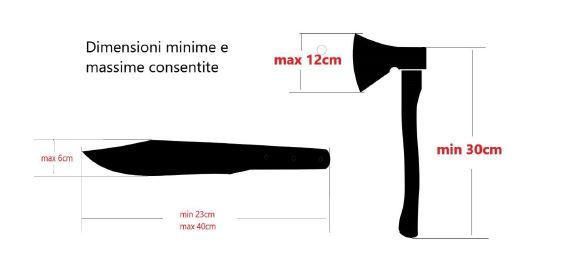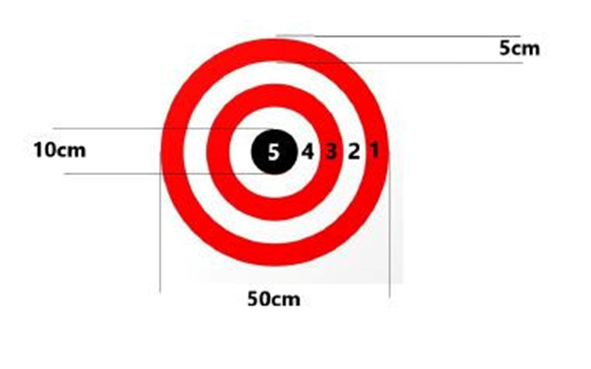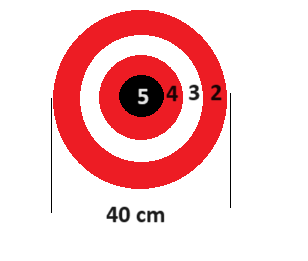This regulation was created to regulate the practice of the sport for throwing safely.
The sport throwing of knives and axes is a sport of precision shooting.
KNIVES
The knives must not be sharpened and must comply with the following dimensions:
Length: Minimum 23cm, maximum 40cm.
Blade width: Maximum 6cm.
Weight: Minimum 170g
AXES (or tomahawks)
They must comply with the following dimensions:
Length: from the bottom edge of the handle to the top edge of the head minimum 30cm.
Cutting edge height: measured in a straight line from tip to tip maximum 12cm.
All equipment can be examined and approved by the competition judge before the start of the competition.

The weights and apparatus measurements shown above are for walk back, long distance, silhouette, duel cup, hunter, nine targets and speed throw competitions. For coutanque competitions, please refer to the relevant regulations.
SAFETY RULES
No tools other than throwing knives and axes are allowed in the camp.
Knives and throwing axes are sports equipment whose improper use can generate dangerous situations.
It is therefore with particular rigor that the following rules must be observed:
a) It is strictly forbidden, both in training and in competition, the use of sharp knives.
b) All instruments must always be thrown to the targets or the ground. Pointing in other directions, even for fun, is strictly prohibited.
c) Unless otherwise specified, the knives must be retrieved by all throwers at the same time. Whoever is going to retrieve the tools must make sure that the others in the throwing line are not completing their series of throws, in which case they will have to wait. Any missing knives can be recovered as long as there is no excessive delay.
Helping to search for knives lost by others is a duty of all competitors.
d) The use of closed shoes is mandatory, sandals or similar are absolutely prohibited.
e) It is strictly forbidden to run with knives and axes in hand.
f) At the time of registration, each competitor must sign a declaration certifying that he/she has read and accepts these regulations.
TIDINESS AND CLEANLINESS
a) The care and cleanliness of the competition field are entrusted to everyone’s civic sense and good manners. Each person has the obligation to take their own waste produced.
b) All participants are required to treat the equipment and facilities present in the competition field with care.
c) All participants are required to report any equipment failure or violation of these regulations to the Manager.
BEHAVIOR AND CLOTHING
Each competitor is required to observe appropriate behavior within the competition field. Any act of disturbance will result in the removal of the person concerned from the field. Damage caused to the organization’s material or that of other competitors, due to negligence or carelessness, must be compensated to the injured parties.
During the stay on the competition field, the competitor must comply with the following rules:
a) Maintain correct physical and verbal behavior.
b) Wear sportswear suitable for the performance of the activity and the decorum of the place.
c) Have the utmost respect for safety regulations and equipment.
d) Be responsible for any damage caused by him or his guests to the facilities and equipment.
e) Hand over throwing materials or other objects found in the launch field to the person in charge.
Marking personal belongings with writings, colors, signs or symbols will facilitate the return to the rightful owner.
f) Smoking should respect the rules of common sense so as not to create situations of annoyance or danger.
g) Remember that knives and axes are potentially very dangerous tools if used in a state of mental alteration. Inappropriate behavior on the throwing lines will result in immediate expulsion from the competition without the need for recalls. Moderate alcohol consumption is therefore permitted. Please also note that the insurance will not compensate the injured person if it turns out that the person who caused the accident had used alcohol or drugs. Those who violate this prohibition will assume all the consequent costs in the event of any accidents, exempting the organization from any liability.
The use of drugs prohibited by law is strictly forbidden both within the competition field and within the host property.
THROWING LINES
Each throwing line must be equipped with 3 targets placed and fixed in a safe, stable manner and according to the provisions provided by the regulations. Each throwing lane must have clear and visible ground lines, perfectly parallel to the targets and arranged at distances of 3 4 5 6 7 meters. Each throwing lane must have an adequate width to allow the thrower to position himself comfortably in front of each target. Throwing lanes should be spaced as far apart as possible. If the distance between them is less than 6 meters, throwers will have to wait until the occupant of the adjacent lane has finished their series of throws before approaching the targets and retrieving the tools. With a distance between lanes of at least 6 meters, throwers will be able to proceed with the recovery of their equipment without waiting. The throwing lanes must be measured and approved by the competition judge before the start of the competition.
TARGETS
Targets must be mounted in batteries of 3 for each throwing lane and comply with the following characteristics and dimensions:

They must be made of wood, which can be in slices of logs (recommended and preferable), assembled of wooden cubes made from beams (so-called “end grain target”), wall of planks (not recommended but acceptable if other solutions were not available).
For layout and measurements, please refer to the images.

The targets must be divided into 5 circular concentric sectors that correspond to the relative scores and must be placed at the respective heights of 150-130-150 cm, measuring from the ground to the exact target center.
In case of impossibility to find targets with a diameter of 50 cm, targets with a diameter of 40 cm are accepted.
Targets with a diameter of 50 cm will have the following colors and scores: Red ring outside 1 point – White ring outside 2 points – Red ring inside 3 points – White ring inside 4 points – Black center (bulls eye) 5 points
Targets with a diameter of 40 cm will have the following colors and scores: Red ring outside 2 points – White ring 3 points – Red ring inside 4 points – Black center (bulls eye) 5 points

Whoever hosts the competition can choose which and how many games they want to have so long as the rules are published for all to see well before the Competition.
ALL COMPETITIONS , LOCAL , NATIONAL AND INTERNATIONAL WHICH USE THE U.K.A.T. LOGO WILL STRICTLY USE THESE RULES

COMPETITION RULES WALK-BACK
Walk-back is the specialty through which the title of National/International/World Champion is awarded, in the throwing of knives and axes, in officially recognized events of adequate level.
The rules are the same for the axe walk-back, the knife walk-back, the no-spin walk-back.
3 identical tools are used, previously verified and authorized by the competition judge.
He throws from distances of 3-4-5-6-7 meters.
Thrown implements must make at least half a turn before hitting the target. (except of course in no-spin)
You start at the 3-meter line and throw a target tool from left to right.
At the end of this series of 3 throws, the scores for each individual throw will be marked by an attendant, generally called a “scorer”.
After that, the thrower can retrieve the tools and move on to the next distance.
This practice will be repeated for any distance up to 7 meters and is referred to as “a walk”. Each walk will therefore consist of a total of 15 throws (3 for each of the 5 distances).
At the end of the walk, the thrower will move back to the 3-meter line and repeat the same practice until the completion of 4 walks.
The race consists of 4 walks, for a total of 60 throws.
SCORE
For each individual throw, the score will be assigned for the sector in which the tool has been inserted. From 5 points for the center to scale up to 1 point for the outermost sector of the target.
In the event that the tool crosses the line between 2 scores, the higher score will be awarded.
For the score to be valid, the tool must be fixed. The visible part in contact with the surface of the target will determine what point you have obtained.
If the tool is not planted, or is planted outside the points area, zero points will be awarded.
The pitcher must have both feet behind the distance line from which he is pitching. If he touches the line with his foot, or crosses it (touching the ground beyond the line with his foot) before the tool has hit the target, the throw is null and void and zero points will be awarded.
The pitcher may move back from the throwing line but must keep at least 1 foot completely within the sector between the distance line from which he is pitching and the next.
If your front foot touches the line of the
next sector, the toss is null and void and zero points will be awarded. Your leading foot must not touch the next distance back.
The maximum score that can be obtained is 75 points per walk, and therefore 300 total points.
In case of disagreement between pitcher and scorer on the recording of scores, the intervention of a referee will be requested whose decision will be final and irrevocable.

COMPETITION RULES LONG DISTANCE
The competition field is made up of consecutive sectors each three meters long. The target must be made of wood and has a diameter of 1 meter. A metric cord must be placed along the competition field precisely. The zero point must coincide with the surface of the target.
The competition starts at 7 meters for the rotational knives and axes while the no spin starts from 5 meters.
The thrower starts the competition from the first sector and has three attempts to stick the tool in the target. Each target point is valid and has the same value.
If he fails all three attempts, his competition ends. If, on the other hand, he manages to plant one of the three tools, he moves on to the next sector, and so on until he misses all three attempts.
The judge must, using a rod, note the exact distance between the tip of the foot and the target of each valid throw.
Of course, the winner of the competition is the one who makes the longest throw.
Visitors






 Users Today : 3
Users Today : 3 Users This Month : 60
Users This Month : 60 Total Users : 215
Total Users : 215 Views Today : 6
Views Today : 6 Total views : 557
Total views : 557